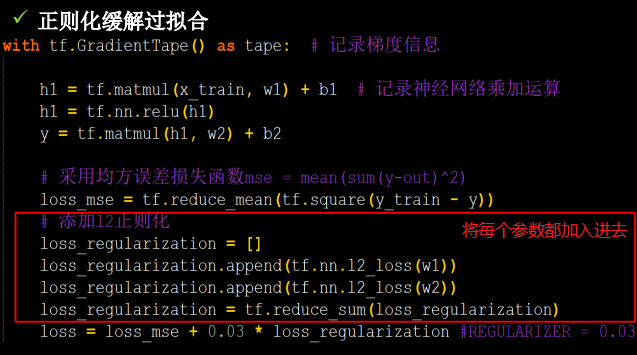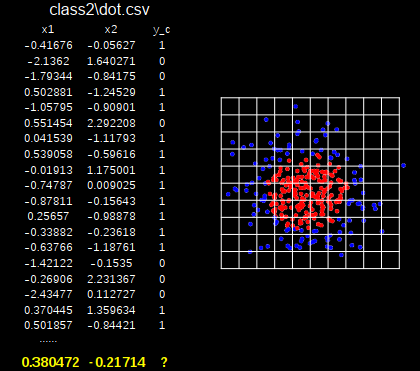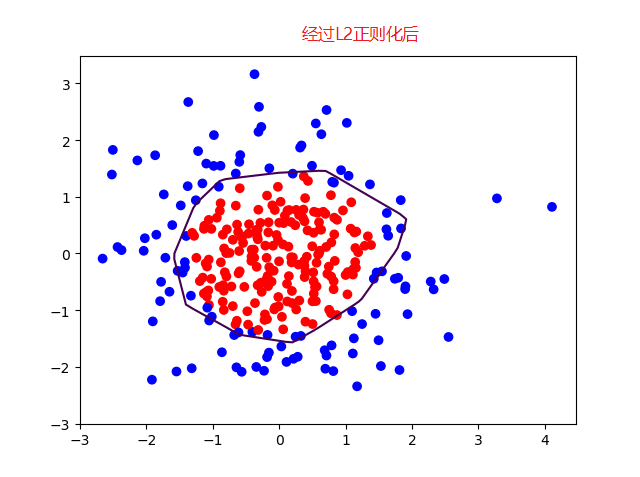缓解过拟合
1.欠拟合与过拟合的解决办法




案例:
实现拟合

(1)不加入正则化

轮廓不够平滑,存在过拟合
#! /usr/bin/env python
# -*- coding:utf-8 -*-
import tensorflow as tf
from matplotlib import pyplot as plt
import numpy as np
import pandas as pd
# 读入数据/标签,生成x_train, y_train
df = pd.read_csv('./datasets/dot.csv')
x_data = np.array(df[['x1', 'x2']])
y_data = np.array(df['y_c'])
x_train = np.vstack(x_data).reshape([-1, 2])
y_train = np.vstack(y_data).reshape([-1, 1])
Y_c = [['red' if y else 'blue'] for y in y_train]
# 转换x的数据类型,否则后面矩阵相乘时会因数据类型问题报错
x_train = tf.cast(x_train, tf.float32)
y_train = tf.cast(y_train, tf.float32)
# from_tensor_slices函数切分传入的张量的第一个维度,生成相应的数据集,使输入特征和标签值一一对应
train_db = tf.data.Dataset.from_tensor_slices((x_train, y_train)).batch(32)
print(train_db)
# 生成神经网络的参数,输入层为2个神经元,隐藏层为11个神经元,1层隐藏层,输出层为1个神经元
# 用tf.Variable()保证参数可训练
w1 = tf.Variable(tf.random.normal([2, 11], dtype=tf.float32))
b1 = tf.Variable(tf.constant(0.01, shape=[11]))
w2 = tf.Variable(tf.random.normal([11, 1], dtype=tf.float32))
b2 = tf.Variable(tf.constant(0.01, shape=[1]))
# 设置学习率
lr = 0.005
# 设置循环轮数
epochs = 800
# 训练部分
for epoch in range(epochs):
for step, (x_train, y_train) in enumerate(train_db):
with tf.GradientTape() as tape: # 记录梯度信息
# 记录神经网络乘加运算
h1 = tf.matmul(x_train, w1) + b1
# 经过激活函数reLu
h1 = tf.nn.relu(h1)
# 计算输出y
y = tf.matmul(h1, w2) + b2
# 采用均方误差损失函数mse = mean(sum(y-out)^2)
loss = tf.reduce_mean(tf.square(y_train - y))
# 计算loss 对各个参数的梯度
variables = [w1, b1, w2, b2]
grads = tape.gradient(loss, variables)
# 实现梯度更新
# w1 = w1 - lr * w1_grad tape.gradient是自动求导结果与[w1, b1, w2, b2] 索引为0,1,2,3
w1.assign_sub(lr*grads[0])
b1.assign_sub(lr*grads[1])
w2.assign_sub(lr*grads[2])
b2.assign_sub(lr*grads[3])
# 每20个epoch,打印loss
if epoch % 20 == 0:
print('epoch:', epoch, 'loss:', float(loss))
##################### 预测 ##############################
print('******************predict*********************')
# xx在-3到3之间以步长为0.1,yy在-3到3之间以步长为0.1,生成间隔数值点
xx, yy = np.mgrid[-3:3:.1, -3:3:.1]
print('xx.shape:', xx.shape)
# 将xx, yy拉直,并合并配对为二维张量,生成二维坐标点
grid = np.c_[xx.ravel(), yy.ravel()]
grid = tf.cast(grid, tf.float32)
# 将网格坐标点喂入神经网络,进行预测,probs为输出
probs = []
for x_test in grid:
# 使用训练好的参数进行预测
h1 = tf.matmul([x_test], w1) + b1
h1 = tf.nn.relu(h1)
y = tf.matmul(h1, w2) + b2
probs.append(y)
# 取第0列给x1,取第1列给x2
x1 = x_data[:, 0]
x2 = x_data[:, 1]
# probs的shape调整成xx的样子
probs = np.array(probs).reshape(xx.shape)
# squeeze去掉纬度是1的纬度,相当于去掉[['red'],[''blue]],内层括号变为['red','blue']
plt.scatter(x1, x2, color=np.squeeze(Y_c))
# 把坐标xx yy和对应的值probs放入contour函数,给probs值为0.5的所有点上色 plt.show()后 显示的是红蓝点的分界线
plt.contour(xx, yy, probs, levels=[.5])
plt.show()
(2)加入L2正则化

对比无正则化与有正则化模型的训练结果,可以看出有正则化模型的拟合曲线平滑,模型具有更好的泛化能力

#! /usr/bin/env python
# -*- coding:utf-8 -*-
import tensorflow as tf
from matplotlib import pyplot as plt
import numpy as np
import pandas as pd
# 读入数据/标签,生成x_train, y_train
df = pd.read_csv('./datasets/dot.csv')
x_data = np.array(df[['x1', 'x2']])
y_data = np.array(df['y_c'])
x_train = np.vstack(x_data).reshape([-1, 2])
y_train = np.vstack(y_data).reshape([-1, 1])
Y_c = [['red' if y else 'blue'] for y in y_train]
# 转换x的数据类型,否则后面矩阵相乘时会因数据类型问题报错
x_train = tf.cast(x_train, tf.float32)
y_train = tf.cast(y_train, tf.float32)
# from_tensor_slices函数切分传入的张量的第一个维度,生成相应的数据集,使输入特征和标签值一一对应
train_db = tf.data.Dataset.from_tensor_slices((x_train, y_train)).batch(32)
print(train_db)
# 生成神经网络的参数,输入层为2个神经元,隐藏层为11个神经元,1层隐藏层,输出层为1个神经元
# 用tf.Variable()保证参数可训练
w1 = tf.Variable(tf.random.normal([2, 11], dtype=tf.float32))
b1 = tf.Variable(tf.constant(0.01, shape=[11]))
w2 = tf.Variable(tf.random.normal([11, 1], dtype=tf.float32))
b2 = tf.Variable(tf.constant(0.01, shape=[1]))
# 设置学习率
lr = 0.005
# 设置循环轮数
epochs = 800
# 训练部分
for epoch in range(epochs):
for step, (x_train, y_train) in enumerate(train_db):
with tf.GradientTape() as tape: # 记录梯度信息
# 记录神经网络乘加运算
h1 = tf.matmul(x_train, w1) + b1
# 经过激活函数reLu
h1 = tf.nn.relu(h1)
# 计算输出y
y = tf.matmul(h1, w2) + b2
# 采用均方误差损失函数mse = mean(sum(y-out)^2)
loss_mse = tf.reduce_mean(tf.square(y_train - y))
# 添加l2正则化
loss_regularization = []
# tf.nn.l2_loss(w)=sum(w ** 2) / 2
loss_regularization.append(tf.nn.l2_loss(w1))
loss_regularization.append(tf.nn.l2_loss(w2))
loss_regularization = tf.reduce_sum(loss_regularization)
# REGULARIZER = 0.03
loss = loss_mse + 0.03 * loss_regularization
# 计算loss 对各个参数的梯度
variables = [w1, b1, w2, b2]
grads = tape.gradient(loss, variables)
# 实现梯度更新
# w1 = w1 - lr * w1_grad tape.gradient是自动求导结果与[w1, b1, w2, b2] 索引为0,1,2,3
w1.assign_sub(lr*grads[0])
b1.assign_sub(lr*grads[1])
w2.assign_sub(lr*grads[2])
b2.assign_sub(lr*grads[3])
# 每20个epoch,打印loss
if epoch % 20 == 0:
print('epoch:', epoch, 'loss:', float(loss))
##################### 预测 ##############################
print('******************predict*********************')
# xx在-3到3之间以步长为0.1,yy在-3到3之间以步长为0.1,生成间隔数值点
xx, yy = np.mgrid[-3:3:.1, -3:3:.1]
print('xx.shape:', xx.shape)
# 将xx, yy拉直,并合并配对为二维张量,生成二维坐标点
grid = np.c_[xx.ravel(), yy.ravel()]
grid = tf.cast(grid, tf.float32)
# 将网格坐标点喂入神经网络,进行预测,probs为输出
probs = []
for x_test in grid:
# 使用训练好的参数进行预测
h1 = tf.matmul([x_test], w1) + b1
h1 = tf.nn.relu(h1)
y = tf.matmul(h1, w2) + b2
probs.append(y)
# 取第0列给x1,取第1列给x2
x1 = x_data[:, 0]
x2 = x_data[:, 1]
# probs的shape调整成xx的样子
probs = np.array(probs).reshape(xx.shape)
# squeeze去掉纬度是1的纬度,相当于去掉[['red'],[''blue]],内层括号变为['red','blue']
plt.scatter(x1, x2, color=np.squeeze(Y_c))
# 把坐标xx yy和对应的值probs放入contour函数,给probs值为0.5的所有点上色 plt.show()后 显示的是红蓝点的分界线
plt.contour(xx, yy, probs, levels=[.5])
plt.show()



